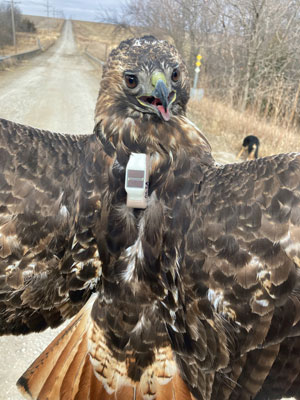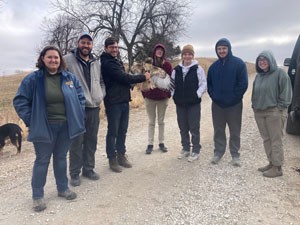Peru, Nebraska – Students at Peru State College are getting a hands-on experience with Red-tailed hawks as part of a research study. Students in the Wildlife Techniques (BIOL 355) class taught by Dr. Lukas Klicka recently accompanied Dr. Klicka and his colleague, Lucas DiCicco of Kansas University, on a trip to tag hawks in northeast Kansas.
“The students got to observe multiple plumage patterns, young and mature birds, bird banding, branchial blood sampling, and we were able to fix two of the transmitters to individuals with intriguing plumage variation,” said Klicka, Assistant Professor of Biology.
Student researchers included Molly Girard (Peru, NE), Ethan Moore (Warsaw, IN), Karley Dieckmann (Holton, KS), Alexx Uecker (Hastings, NE), Alex Carnoali (Easton, KS), and Caden Rush (Omaha, NE).
“The last bird we caught was perfect for a tracker,” said Dieckmann. “We watched as Lucas put the tracker on with great precision, named her J Lo and sent her on her way. This lab assured me that I’m on the right path with my degree.”
Moore explained that J Lo’s coloring made the bird ideal to study: “The final bird we trapped had a unique, contradictory pattern to it: Overall it looked like a far Northwestern bird, with dark coloration and a dark chest. However, its tail was completely red, with no barring or splotching, which is characteristic of birds from the Southeast.”
The work completed at Peru State is in support of the PhD dissertation research of Bryce Robinson at Cornell University. His work is currently focused on resolving the taxonomy (naming populations) and systematics (relationships between populations) of the 14 recognized subspecies of Red-tailed hawks. The migratory populations that over-winter in Kansas and Nebraska will often breed in very remote areas of Canada and Alaska. Thus, the trackers allow the researchers to confidently assign individuals to breeding populations and then examine genetic differences between the breeding populations. Future studies on movement ecology (where, when and why the birds move) and the genomics of polymorphism are two exciting avenues of research that these data will also support.
Klicka explained, “Ultimately, we will have 1–2 years of data for these birds’ migratory paths. It’s a really cool opportunity for the students to get out of the classroom, and to have their work used much more broadly to elucidate patterns within Red-tailed Hawks.”
Students involved in the study will present their research at the annual Research and Creativity Expo held on at the College. The work is supported by a Student Engagement Enhancement grant from the College.
“Overall, I thought it was an excellent lab, one of the best I've had in college thus far,” said Moore. “I learned a lot, I had fun, and it showed me that there's always things to be learned and studies to be done; even in something as ubiquitous as the Red-tailed hawk.”
Peru State’s “Campus of a Thousand Oaks”, an arboretum campus, is nestled in historic southeast Nebraska. The state’s first college, Peru State provides students of all backgrounds access to engaging educational experiences to strengthen and enrich communities, Nebraska and the world.

J Lo, showing off her tracker.
#PeruState155
